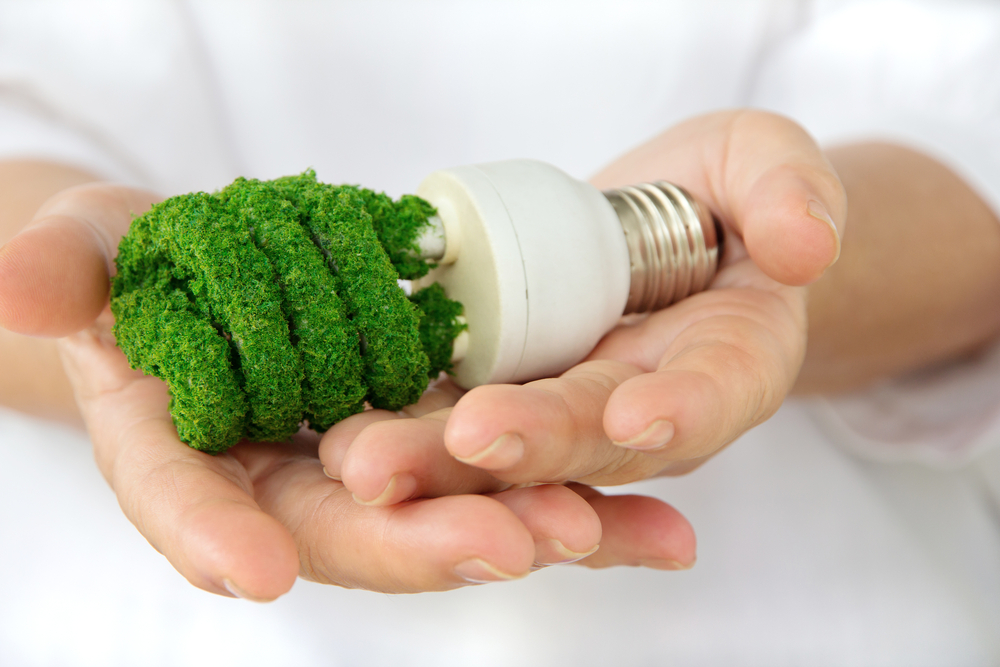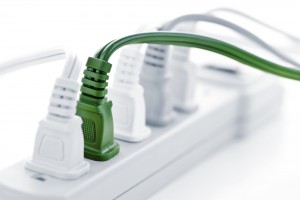Introduction
Energy efficiency is the cornerstone of My Green Doctor. This is where a doctor’s office can capture the greatest financial savings and make the strongest community impact. lMost of our offices are planned for patient care, and rarely with consideration for the cost of office operation and energy usage. Yet utility costs add substantially to the cost of doing business.
The word “energy” was coined by Aristotle, the 4C BCE Greek philosopher, to mean “at work.”When we use electric power we are getting work accomplished.”Energy efficiency” is the wise use of this work.
There are two key tenants to remember as you approach this topic: first, the cheapest kilowatt for your office will be the one that you never use, so cut your power use wherever you can; and second, look immediately for the “low hanging fruit,” the quick and inexpensive ways to save.
We provide dozens of Action Steps that your office can adopt for lowering your energy use and saving money. This will reduce the amount of fossil fuels used to generate electricity, reducing both the national fuel bill and the air pollution from the burning of these fuels. Every idea in this Workbook can be taken home to share with your family and your patients’ families.
Energy Efficiency Action Steps
We offer 50 Energy Efficiency Action Steps and Education Steps for you to consider for your office. We suggest that you begin with the five “Quick Start, Now!” Action Steps.
At your next meeting, consider some of the “Advanced Route” Action Steps for Energy Efficiency. Some of these require more planning and team work but they offer great long term rewards. A thorough energy efficiency plan may take months to formulate.
Finally, consider the “Education” Action Steps for Energy Efficiency in order to share energy concepts with your staff, families and patients.
We will lead you through each action step and challenge your Green Team to create new ideas by asking, “What else?” Please email us your ideas to add to the Workbook. These suggestions will help you toward Green Doctor Office Recognition.
Quick Start Now! Action Steps for Energy Efficiency
Adopt a policy to turn off lights, computers, monitors, fax machines, copiers and printers at night. This saves a lot of energy and money. Set computer monitors to “sleep mode” if they must stay on. Plug all machines into power strips to make it easy to turn them off at night with just one button. You might tape reminder messages onto machines to “Please turn me off!”. Speak with your janitorial staff who might be leaving the lights on at night.
Issues to discuss:
- Can we agree to do this?
- Do a quick mental inventory of your machines & lights: are there some that must stay on?
- Who will be the leader for this Action Step and report back at the next meeting?
Does your office receive monthly energy bills? If you are in a large building, you may not receipt a separate bill for the energy that you use. If you do get monthly bills, ask one Green Team member to gather your bills for the past year, and to report your future energy savings every 2-3 months. Your utility’s website likely can tell you how to calculate how much carbon dioxide you are reducing – the greenhouse gas that is causing most climate change.
Issues to discuss:
- Can we agree to do this?
- Who will be the leader for this Action Step & report back in 2-3 months?
Change all incandescent lights (those with filaments inside) to Compact Fluorescent Bulbs (CFB’s) or to Low Emitting Diode (LED) bulbs. LED’s are preferred because they use so very little electricity. A 75 watt incandescent bulb is replaced with a 25W CFB.
Issues to discuss:
1. Can we agree to do this?
- Do we have dimmer switches that don’t allow bulb changes?
- Fluorescent bulbs contain mercury, a potent neurotoxin. The typical CFB contains 5mg, compared with 100mg in a mercury thermometer. Do we have a plan to discard used bulbs properly. Most hardware store accept these, or check www.earth911.com/recycling, or call your trash collector or local government.
- Who will be the leader for this Action Step and report back at the next meeting?
Adopt an office policy to set thermostats to 74 degrees F (23 C) in the summer and 68 F (20 C) in the winter. Put reminder stickers on the thermostats for these settings.
Issues to discuss:
- Can we agree to do this?
- Do we need to coordinate this with the building manager?
- Who will be the leader for this Action Step and report back at the next meeting?
Most doctor offices can turn off their hot water heaters, without health consequences. Hand-washing requires soap & water, but not heat. A large public health clinic in Pensacola, Florida studied this option, found it to be safe, and is saving hundreds of dollars annually.
Issues to discuss:
- Can we agree to do this?
- Who will be the leader for this Action Step?

Keep Going! More Action Steps for Energy Efficiency
Learn how much energy you use and how you use it.You can perform your own office energy audit or make use of free audits that are provided by most local electric utility companies, either in person. This service is provided because utility providers are encouraged by the government and by the marketplace to promote wise energy use in order to avoid building expensive power plants and to avoid burning fossil fuels. Click here to learn more about calculating your annual contribution to greenhouse gases.
Gather your bills for the past year. If you are in a building with many tenants, you may need to obtain a copy of the bills from your landlord.Ask a Green Team member to study your bills carefully for energy-saving tips from your utility company. Bring ideas back to the Team. Review these regularly, perhaps every three months.Go to the website of your local utility company to learn what advice or audit services are available.Decide whether to use an expert from your utility or to perform your audit yourself using an online program. Alternatively, your utility company might provide the names of consultants they consider to be reliable for evaluating small businesses. You may contact the GDOP if you would like us to help you find an expert in your area.
Identify who in your office will supervise the audit process. Choose a date for completion of your audit. Ask someone on your Green Team to learn and teach about office energy use (this is also a great school project for the child of a Team member). Use your electricity and gas bills for one month to report what your office spends on power. Go online to your utility provider to learn what fuels are consumed to produce the energy used in your office. Calculate the greenhouse gases produced by this. List the air pollutants that result, and five related health or environmental consequences. Educate your staff and/or patients by reporting this information at a staff meeting, or in a handout for employees and patients. Download and print the brochure, “Energy Conservation: Take It Home, Save Energy and Money.” Give it to your office staff and place copies in the waiting room.
Visit the office next door, or on the next floor, to speak with the office manager about how easy it is start a Green Team. This step is especially valuable for you if you rent your office and share with your neighbors the costs of electricity, water, and gas. As your neighbors save electricity, you save money too!
A carbon footprint is a measure of the amount of greenhouse gases, including carbon dioxide, emitted as the result of the activities or operations of a person, household, business, medical practice, or other entity. Carbon dioxide and other pollution is created when electricity is produced by your utility company by burning non-renewable fossil fuels such as coal, natural gas, and petroleum. Using your electric bill and other simple information, you can easily calculate your family’s or your medical office’s annual greenhouse gas production — your “climate footprint.” A straight-forward calculator is available from the US Environmental Protection Agency (EPA): https://www.epa.gov/ghgemissions/household-carbon-footprint-calculator . This calculator considers daily activities including your use of electricity, transportation methods, and disposal of wastes, the most common sources of household or office greenhouse gases. Of course, the EPA calculator will not be accurate for many household around the world that may use wood, coal, natural gas or other fuels. You can find on line other calculators that may be better for you.
Calculate your office’s greenhouse gas production for one year. Track this annually in the future.Calculate the greenhouse gas production for the families of each member of your office or of your Green team.Prepare a one-page handout for your patients about greenhouse gases: where they originate, how the climate is changing, and how this will change the economy and health of your community 100 years from now. Encourage patients to try the green house gas calculator for their households.
Conserving energy can be as simple as turning off the lights when they’re not in use. Put “Please turn me off” stickers on switches, including in the waiting rooms. These can easily be made with the label printing program that is likely on your desktop computer at work. Teach members of the office and the cleaning team. Turn off lights when the natural light from windows is adequate. Also, start a friendly office competition to see who can turn off the most lights each week. Do not replace unneeded bulbs. Adopt a policy to not replace burned-out tubular fluorescent bulbs if the remaining bulbs in your fixture provide adequate light. Speak with your maintenance personel. Come up with creative ways ways to teach everyone working in the office about lighting options and the policies you have adopted. In addition to these steps, also consider:
Change all incandescent lights to CFB’s (except where dimmer switches do not allow a CFB). A 75 watt incandescent bulb is replaced with a 25W CFB. Properly discard used fluorescent bulbs. A CFB contains 5 mg elemental mercury, compared to 100 mg in a mercury thermometer. Contact your supplier, hardware store (such as Home Deport), www.earth911.com/recycling, or call your local government to learn your local procedures. Teach every member of your office, including the cleaning and maintenance staff, about proper CFB disposal.Replace old tubular fluorescent fixtures with modern, efficient T-8 fixtures. This saves money and the T-8 bulb has an improved Color Rendering Index (CRI) of 75 that is pleasant for office work. An electrician is needed to change fixtures but not for changing bulbs.Look for LED (light-emitting diodes) fixtures and bulbs that are becoming less expensive. LEDs use the same technology that illuminates cell phone screens. They are highly attractive, require almost no electricity, and last practically forever, but are still quite expensive at $20-30 per bulb. They are available online, at specialty bulb shop, and at large hardware stores.
Use desk lamps to focus on a project when the ceiling lights are not needed. CFB and LED task lighting are great savers!Install motion sensors for the lights in all restrooms, halls and conference rooms. An electrician is needed for this but the change is guaranteed to pay for itself over time.
The simplest way to build a greener office through the use of office equipment is to adopt a policy to turn off lights, computers, monitors, fax machines, copiers & printers at night. This saves a lot of energy and money. Set computer monitors to “sleep mode” if they must stay on. Plug all machines into power strips to make it easy to turn them off at night. Put reminder messages on machines to “Please turn me off!” Speak with your janitorial staff who may leave lights on at night. To make this step easier, install power strips. Buy power strips to plug into multiple machines, making it easier to turn the machines off at night. Ask office members if they can use power strips for their office spaces. Also, adopt an office policy to ask employees to engage the energy saving buttons after they have completed using a copier or fax machine. Try to do this every night when the office closes. Place a small sign on devices to tell users which button to use. Mention this at staff meetings. This saves energy, reduces the heat generated by machines, and cuts down on the noise.
Adopt a policy to purchase only Energy Star electrical equipment in the office, where available.Ask your vendor or see www.energystar.gov. This includes business machines (e.g. computers, monitors, fax machines, printers, shredders); lunchroom machines (coffee pot, toaster, refrigerator); and medical equipment (electrical thermometers, scales, washing machines for linens).Prepare a handout for those working in the doctor office and for you patients about Energy Star appliances and wise use of electrical equipment.Appliances such as space heaters, personal coffee pots, cup warmers, and air fresheners are often cheaply-made, inefficient devices that also may be fire hazards. They are “energy hogs”! Exceptions can be allowed for small portable fans (which could allow you to set the air conditioner at a warmer setting) and devices needed for health reasons, such as portable oxygen generators.Download and print the brochure, “Using Appliances Wisely: Put Money in Your Pocket, Help the Environment.” Give it to your office staff and place copies in the waiting room.
Control the temperature of your office thermostat. Adopt an office policy to set thermostats to 74 degrees F (23 C) in the summer and 68 F (20 C) in the winter. Put reminder stickers on the thermostats for these settings. Assign a Team Member to inspect the office thermostats weekly or as needed. Communicate thermostat settings with those working in the office. Encourage the wearing of comfortable, climate appropriate clothing, such as open-collars and short-sleeved shirts during warm weather; sweaters and coats during cool months. Use natural, cool materials.
Have your electrician install programmable thermostats allowing you to substantially lower your electricity use at nights and on weekends. Be sure an office manager knows how to program these for the office.Install motion detectors to turn off the heat or air conditioning in a room when the room is not in use. Some heating/cooling systems will not allow this type of adjustment; your vendor or an energy consultant can advise you. To save cooling and heating costs, post small signs on all exterior doors stating, “Do not prop door open. To save energy, and for your safety, doors must be closed after use.” Remind members of this, and its environmental importance, at your office staff meetings. Thanks to the Escambia County Health Dept for this idea!
Perform a heating, ventilation and air conditioning (HVAC) assessment, (usually done by a consultant). This is now a highly skilled, mathematical engineering specialty. Your utility or air conditioning provider can suggest an expert. Consider an infrared camera survey for interior and exterior building heat leaks. Consider replacing older, inefficient machines with energy-saving modern units.Adopt a policy to perform all manufacturer-recommended inspections, upgrades, air filter changes on your HVAC equipment, and annual cleaning of HVAC ducts and vents. Include checking that vents are not blocked by furniture or carpeting. Contract with a specialist for this to be done properly. Designate someone in the your office to be responsible for your heating, ventilation and air conditioning (HVAC) systems. It is wise to have your HVAC inspected regularly– at least twice a year– but also on the schedule recommended by the manufacturer of your equipment. This Action Step is often overlooked in small offices but makes a big difference for energy savings.
Prepare a handout for those working in the office and for your patients about HVAC systems, thermostats, sensible room temperatures, and the financial and environmental benefits of wise settings.
To ensure maximum protection, upgrade your windows. If your building is over ten years old, it may pay to upgrade to double-paned, insulated glass. Low interest loans or grants may be available from your government, utility company, or your bank. Contact your utility company, energy consultant, building manager, or architect.
Install window blinds or drapes to prevent heat entry or escape. Instruct office members about the use of these; for example, to open blinds on a cold, sunny day to allow natural warming of a room.Install window tinting, especially on south-facing windows. This can be highly cost effective, and most communities have vendors who will compete for your business. Contact your utility company, building manager, or energy consultant.Annually check the condition of window and door caulking. Check for cracked or broken windows. Ensure that someone in the office is responsible for these maintenance details.
Add building insulation for the building’s wall, crawl spaces and roof. Consider adding foam insulation, such as Icynene, that adds more insulation. Speak with your building manager, architect, or energy consultant.Prepare a handout for your office staff and patients about the advantages of building insulation, available options, energy savings, and community health benefits arising from less energy consumption.Prepare a brochure or handout for those working in the office and for your patients about windows, caulking, and insulation.
Consider turning off your hot water: Turn off the hot water machines for your entire building. This Action Step was researched and adopted in 2010 by the public health specialists of the Escambia County Health Department and found to be safe and to produce large savings of money and carbon emissions. Their five outpatient clinics care for complex patients including ones with serious infectious diseases, but they found that you do not need hot water for effective hand-washing. If you do wish to keep your hot water heater, set the temperature to 120 degrees F (48 degrees C), no higher.
Make a visit to your water heater. Insulate the hot water tank with a thermal blanket; insulate your pipes as well.Install a solar hot water heater if the current heater is 10 years old or older, and if you have a suitable roof location on your building. Significant rebates may be available from your utility company, state government, or Federal government, so that your solar unit will pay for itself in about 5 years.Convert to a “tankless” water heater (such as Rinnai or Hubbell brands) if the current heater is 10 years old or older. Tankless heaters save energy by not keeping a tank of water hot round-the-clock when the office is not using hot water.
What else? Please email us your “What Else” ideas for us to add to the Workbook. These suggestions will help you toward Green Doctor Office Recognition.
Tips for Success
Your Improvement Plan consists of the Action Steps that you choose to adopt for the office.
For each action step:
- Record the conditions in your office before you start making improvements, such as your monthly electricity use.Record these data on a Green Team Notes form on a Green Team worksheet.
- Establish specific, measurable, date-certain targets for what you want to accomplish such as, “We will turn off 100 percentof appliances at night by September 1,” or “We will agree on and implement a thermostat setting policy for the office by January 1.”
- Agree on a leader for each Action Step.
- Agree on the responsibilities of each person in the office.
- Pick a date for a progress report for each Action Step, or a date for completion.
- Use the Green Team Notes form to keep track of your progress. Try to share this online to avoid printing paper.
- If needed, obtain agreement or approval from the office manager or chief executive.
- Communicate with your office colleagues. Listen for ideas and try to elicit helpful criticisms.
- Educate your patients, families, and community. Which ideas could be shared with your own families or with your patients?
- Part of the Green Team’s Improvement Plan must include an education plan.Your waiting room can become a site for education.



